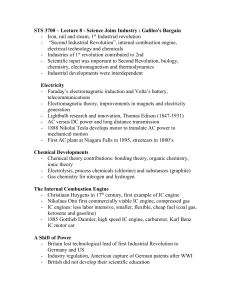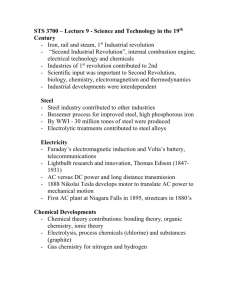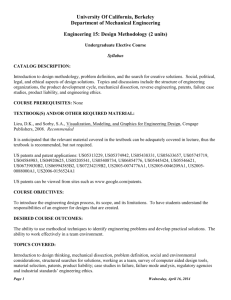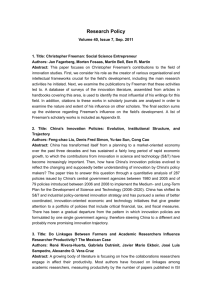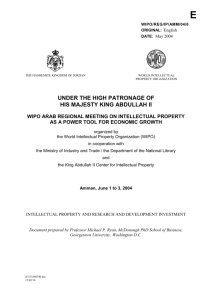NATS 1840 Lecture 12 – Science and Engineering In Industry
advertisement
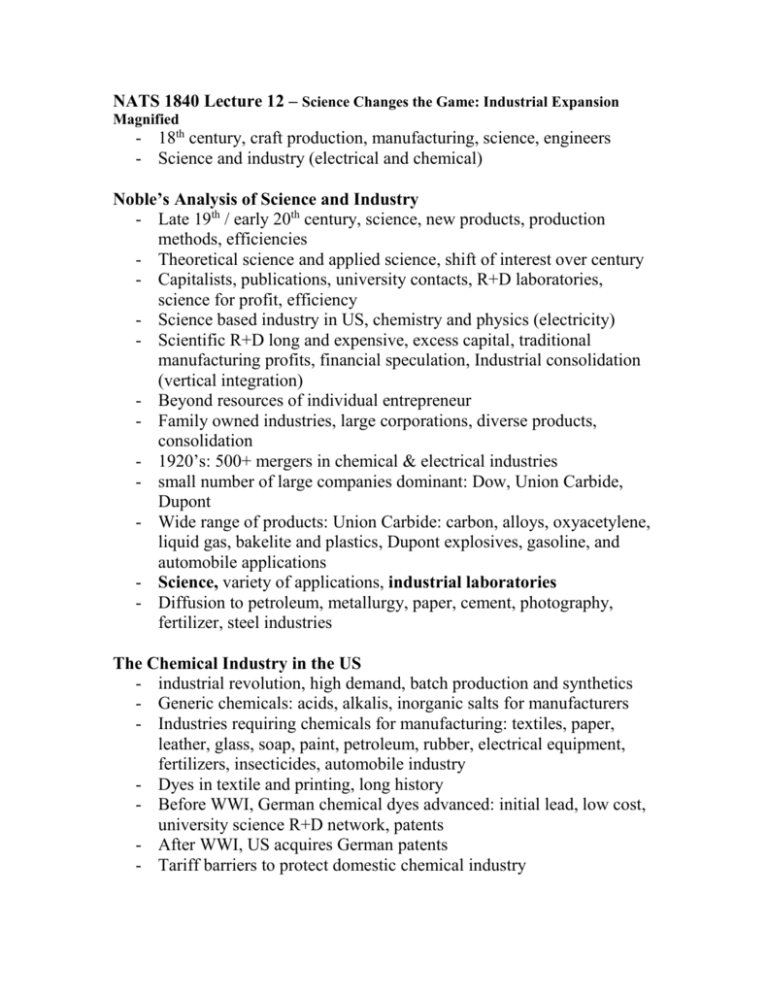
NATS 1840 Lecture 12 – Science Changes the Game: Industrial Expansion Magnified - 18th century, craft production, manufacturing, science, engineers - Science and industry (electrical and chemical) Noble’s Analysis of Science and Industry - Late 19th / early 20th century, science, new products, production methods, efficiencies - Theoretical science and applied science, shift of interest over century - Capitalists, publications, university contacts, R+D laboratories, science for profit, efficiency - Science based industry in US, chemistry and physics (electricity) - Scientific R+D long and expensive, excess capital, traditional manufacturing profits, financial speculation, Industrial consolidation (vertical integration) - Beyond resources of individual entrepreneur - Family owned industries, large corporations, diverse products, consolidation - 1920’s: 500+ mergers in chemical & electrical industries - small number of large companies dominant: Dow, Union Carbide, Dupont - Wide range of products: Union Carbide: carbon, alloys, oxyacetylene, liquid gas, bakelite and plastics, Dupont explosives, gasoline, and automobile applications - Science, variety of applications, industrial laboratories - Diffusion to petroleum, metallurgy, paper, cement, photography, fertilizer, steel industries The Chemical Industry in the US - industrial revolution, high demand, batch production and synthetics - Generic chemicals: acids, alkalis, inorganic salts for manufacturers - Industries requiring chemicals for manufacturing: textiles, paper, leather, glass, soap, paint, petroleum, rubber, electrical equipment, fertilizers, insecticides, automobile industry - Dyes in textile and printing, long history - Before WWI, German chemical dyes advanced: initial lead, low cost, university science R+D network, patents - After WWI, US acquires German patents - Tariff barriers to protect domestic chemical industry - US industry processes: catalytic, liquefying of air, electrochemical, organic synthesis - Foreign processes, out producing sources by turn of century - Electrolytic process: salts, soda, chlorine and bromine The Reciprocal Relationship between Science and Industry - Science: new processes and products, monopolies, patent control - Applied scientific research, industry needs, curriculum Industrial Momentum and the Electrical Industry - Turn of century US electrical industry monopolized, key innovations and patents - Electrical power generation, lighting, transportation and communications industries in late 1800’s - Electrical industry engineers and scientists moved to other industries, spread use of patents, research laboratories and technical training - ATT (telephones), GE & Westinghouse (lighting, power, traction) - Reliable current, efficiency, standardization, reliability - 1885 Westinghouse, alternating current Patents and Innovation - 17 year patents, securing patents and mergers for control - Edison laboratory Menlo Park, New Jersey - Market guide for innovations, incandescent lighting at gas lighting prices, improvements to lower price - Technological systems complex, network of innovations, ownership of relevant patents - Edison General Electric and Thomson-Houston merged into GE - Patent appropriations & mergers led to ATT dominance - Patent maintenance and pursuit expensive and time consuming, patent pools - Patents are idea protection, complexity, science Vertical Integration - Supplier of product merges with product user: vertical integration - Industrial processes, science, capital intensity, vertical integration reduction of transaction costs, supply and price guarantees - Share purchase / mergers between chemical companies and product users (automobile industry) - Share purchase / mergers with companies that produced their raw materials, eg. Copper, potash, sulfur, phosphate and nitrate - Internal demand for greater purity, volume and variety of products - 1910, US chemical companies scope wide, medicinal and fine chemicals - Dupont and explosives, dynamite, nitroglycerine and black powder Conclusion: The “Scientific Revolution” in Industry - Electrical & chemical industries in US, 19th / 20th century, added scientific knowledge to their processes - This required: o Control and purchase of patents o Scientific training for employees o Large scale industrial scientific R+D Electrical and chemical engineers and scientists, “scientific revolution” in industry, identity of corporate and scientific advancement
